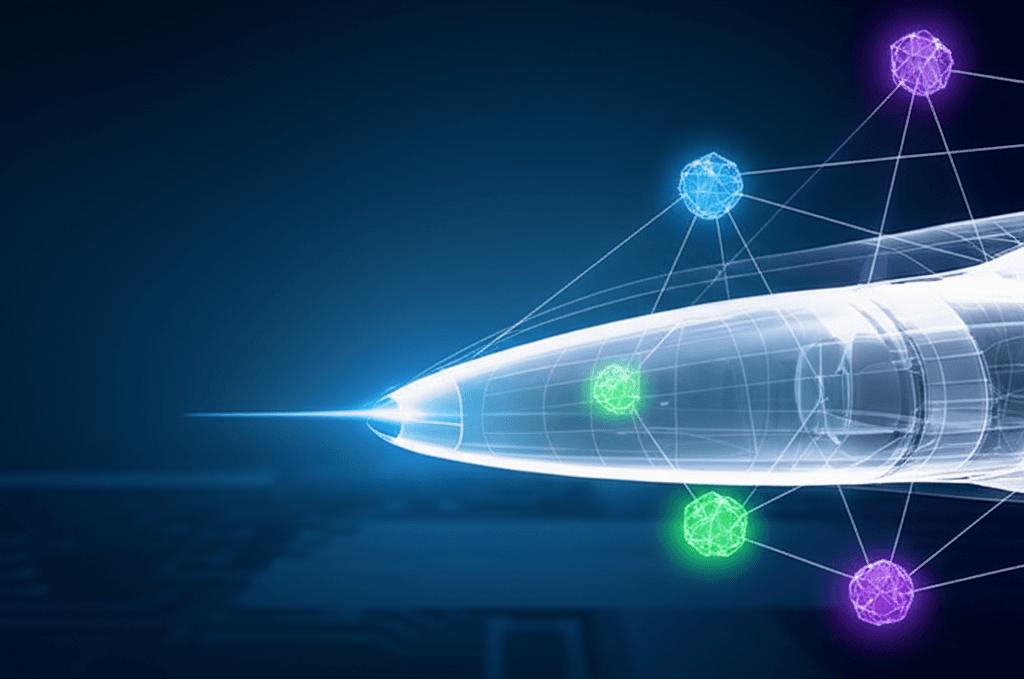Multi-Agent AI Transforms Aerospace: Eliminates Costly Interoperability Glitches
Unveiling multi-agent AI that empowers aerospace to overcome integration hurdles, accelerate production, and build the future of flight.
June 23, 2025

A new frontier in aerospace manufacturing is being forged with the introduction of a generative AI platform designed to tackle persistent and costly interoperability challenges. Unveiled at the prestigious Paris Air Show, an enterprise generative AI company, Articul8, showcased a next-generation multi-agent, domain-specific AI platform. This system is engineered to have artificial intelligence agents actively reason, collaborate, and resolve complex engineering problems throughout the entire aerospace lifecycle, from initial design to the final stages of manufacturing execution. The platform's debut marks a significant step forward in applying AI to the intricate world of aviation production, promising to reduce errors and delays that have long plagued the industry. The initial demonstration of this technology focused on a common yet critical issue: the failure of different aircraft components, supplied by various manufacturers, to integrate seamlessly during final assembly.
The core of the innovative platform lies in its use of multiple, specialized AI agents that work in concert to identify and rectify issues before they escalate into costly production bottlenecks.[1] Articul8 demonstrated the system's capability by addressing a real-world aerospace problem: the incorrect merging of a radome, the nose cone covering of an aircraft, with the main nose cone structure.[1] This type of integration failure often occurs due to minute misalignments in geometry, inconsistent specifications, or undocumented discrepancies between parts from different suppliers, even when each component is technically within its own tolerance limits.[1] In the demonstration, a "Supplier Agent," equipped with a domain-specific model for geometry, flagged a potential conflict. This triggered a "Compliance Agent" to verify that the proposed fix from the Supplier Agent adhered to all necessary engineering and regulatory standards. Finally, a "Manufacturing Agent" confirmed that the suggested modification could be implemented on the factory floor without disrupting existing workflows. This orchestration of AI agents, each with its own specialized knowledge, allows for the proactive detection and resolution of conflicts in real-time, complete with full traceability and enterprise-grade compliance.[1] This moves beyond passive AI tools that simply generate outputs, creating a system where AI can actively participate in the problem-solving process.
The launch of this platform arrives as the broader aerospace industry is increasingly turning to generative AI and digital transformation to navigate a host of challenges.[2] Major players like Airbus are already exploring hundreds of use cases for generative AI, ranging from assisting engineers with complex technical documentation to optimizing manufacturing instructions and supply chains.[3][4] The concept of the "digital twin," a virtual model of a physical object or system, is becoming central to the industry's strategy. By creating highly detailed simulations, aerospace companies can test and validate designs, predict maintenance needs, and optimize performance before a single physical part is manufactured.[5][6] Generative AI enhances this process by rapidly creating and evaluating thousands of design possibilities, optimizing for factors like weight, aerodynamics, and material strength.[7] This allows for the development of more efficient and cost-effective aircraft. The industry is under immense pressure to increase production rates for commercial aircraft while simultaneously designing the next generation of more sustainable, decarbonized planes.[5] Digitalization, powered by AI, is seen as a critical enabler to meet these ambitious goals.
The technological underpinnings of a platform like Articul8's represent a significant evolution in artificial intelligence, moving towards collaborative, multi-agent systems. The challenge in many complex industries, including aerospace, is that data and expertise are often locked in silos.[1] Different teams and suppliers work with their own systems and models, making seamless integration difficult. The concept of AI agent interoperability, where different AI programs can communicate and collaborate regardless of their underlying framework, is emerging as a solution to this fragmentation.[8][9] This is analogous to how standardized protocols like HTTP enabled the explosive growth of the internet by allowing different computer systems to communicate effortlessly.[10] By creating a common language for AI agents, they can be orchestrated to tackle multifaceted problems that no single AI could solve on its own.[11][12] This allows for the creation of a dynamic, intelligent ecosystem where AI agents can sense the environment, learn from new data, and make decisions to optimize complex processes like an aircraft assembly line.[13]
The implications of this shift towards collaborative AI in aerospace are profound. By embedding expert logic into AI agents that can oversee and manage the integration of complex components, the industry stands to gain significant efficiencies.[1][4] This technology can drastically reduce the costly and time-consuming manual interventions required to fix interoperability issues on the assembly line. Furthermore, it can lead to higher quality products by catching potential flaws at the earliest stages of the design and manufacturing process.[14] As these AI systems become more sophisticated, they could automate and optimize larger portions of the supply chain and production schedule, leading to faster time-to-market for new aircraft.[15] The introduction of multi-agent AI platforms at major industry events like the Paris Air Show signals a maturation of generative AI, moving it from a tool for content generation to a core component of complex, industrial problem-solving. This heralds a future where human engineers are augmented by teams of collaborative AI agents, working together to build the next generation of aircraft with greater precision and efficiency than ever before.
Sources
[2]
[3]
[5]
[6]
[10]
[12]
[13]
[14]